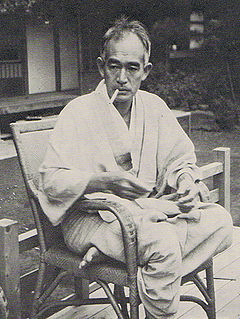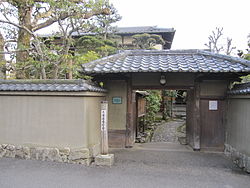- Naoya Shiga
-
Naoya Shiga 
Born 20 February 1883
Ishinomaki, Miyagi, JapanDied 21 October 1971 (aged 88) Occupation writer Genres short story, novel Literary movement I Novel Naoya Shiga (志賀 直哉 Shiga Naoya, 20 February 1883 – 21 October 1971) was a Japanese novelist and short story writer active during the Taishō and Showa periods of Japan.
Contents
Early life
Shiga was born in Ishinomaki city, Miyagi prefecture. His father, the son of a samurai, was a banker. The family moved to Tokyo when Shiga was three, to live with his grandparents, who were largely responsible for raising him. Shiga's mother died when he was thirteen and his father remarried not long after. Shiga graduated from the Gakushuin Peer's School and attended Tokyo Imperial University, where he met Uchimura Kanzō (who converted him to Christianity). However, he left university without graduating.
Literary career
While Shiga was at the Gakushuin he became friends with Saneatsu Mushanokōji and Kinoshita Rigen. His literary career began with a handwritten literary magazine Boya ("Perspective"), which was circulated within their literary group at the school. In 1910 Shiga contributed the story Abashiri made ("To Abashiri") to the first issue of the literary magazine Shirakaba ("White Birch").
In longer works, Shiga generally adhered to the indigenous I Novel literary form, which uses the author's subjective recollection of his own experiences, but he established his reputation with a number of short stories, including Kamisori ("The Razor", 1910), Seibei no hyotan ("Seibei and the Gourd", 1913) and Manazuru ("Manazuru", 1920). These were followed by novels, including Otsu Junkichi (1912), Wakai ("Reconciliation", 1917), and his major work, An'ya Koro ("A Dark Night's Passing", 1921–1937), which was serialized in the radical socialist magazine Kaizō.
Shiga's terse style influenced many later writers, and was praised by Ryūnosuke Akutagawa and Agawa Hiroyuki. However, other contemporaries, notably Dazai Osamu, were strongly critical of this "sincere" style.
During his lifetime Shiga moved house more than 20 times. He wrote stories connected with most of the places he lived in, including Kinosaki ni te ("At Cape Kinosaki") and Sasaki no bai ("In the case of Sasaki"). He lived in the hot spring resort town of Atami, Shizuoka from the war years onwards. Frequent visitors to his house included the writer Hirotsu Kazuo and the film director Yasujirō Ozu.
Later life
Shiga was awarded the Order of Culture by the Japanese government in 1949.
Shiga suffered the fate of many authors who are successful in their early years, combined with the fatal weakness of authors specializing in the autobiographical novel – after a while there is little or nothing left to write about. During the last 35 years of his life he occasionally appeared as a guest writer in various literary journals, where he reminisced about his early association with various Shirakaba school writers, or his former interest in Christianity, and he was given the title Shosetsu no Kami-sama (“God of Fiction”) by his fans, but he produced very little new work. He died of pneumonia, after a long illness, at the age of 88.
See also
- Japanese literature
- List of Japanese authors
Translation
- Dunlop, Lane, The Paper Door and Other Stories by Shiga Naoya, San Francisco: North Point, 1987. ISBN 0-86547-419-2
References
- Agawa, Hiroyuki. Shiga Naoya. Iwanami Shoten (1994). ISBN 4000029401
- Kohl, Stephen William. Shiga Naoya: A Critical Biography. UMI Dissertation Services (1974). ASIN: B000C8QIWE
- Starrs, Roy An Artless Art - The Zen Aesthetic of Shiga Naoya: A Critical Study with Selected Translations. RoutledgeCurzon (1998). ISBN 1873410646
External links
Categories:- 1883 births
- 1971 deaths
- People from Miyagi Prefecture
- Japanese novelists
- Japanese short story writers
- University of Tokyo alumni
- Recipients of the Order of Culture
Wikimedia Foundation. 2010.

